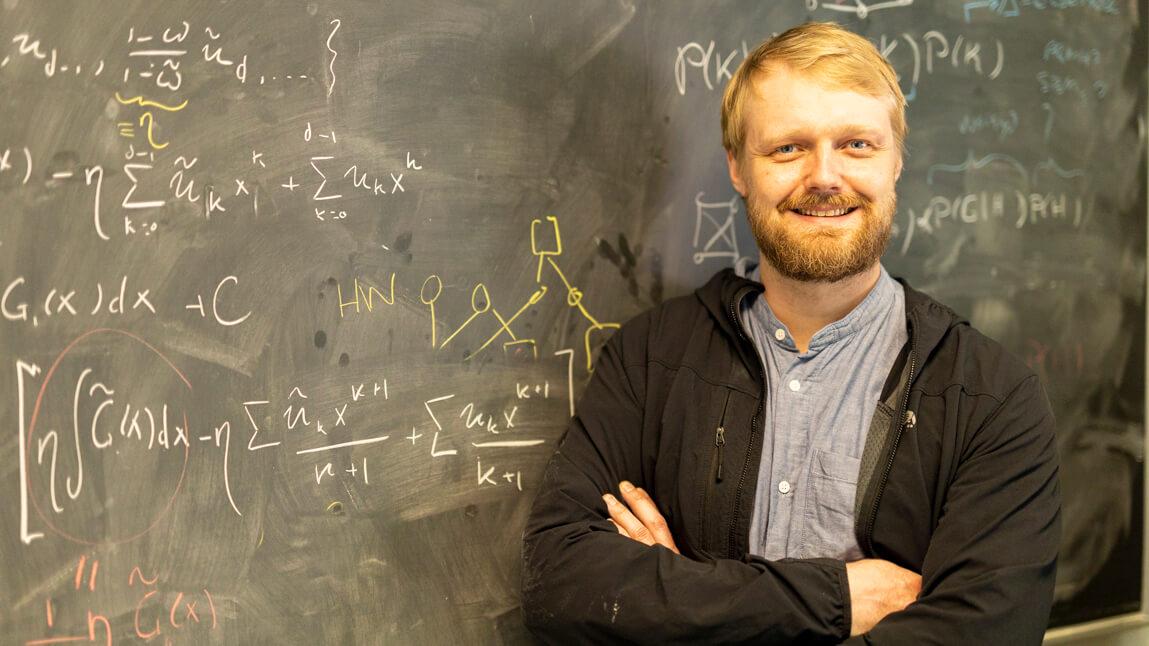Jean-Gabriel Young, an assistant professor in the College of Engineering and Mathematical Sciences (CEMS), was recently awarded an Early Extra Promotion of Research & Scholarly Success (EXPRESS) grant, an internal, competitive funding program — sponsored by the Office of Research — designed to stimulate research and scholarship by new junior faculty members.
Dan Harvey, Director of Operations in the Office of Research and Assistant Dean of the Graduate College, started the EXPRESS grant to jumpstart early UVM faculty members’ research career.
“The goal is that these awards will aid in the initiation of the research, scholarship, and creative works that will propel the careers of new faculty members,” Harvey said. “We started the EXPRESS grant program in 2015 to level the research grant playing field. Faculty in history, art, and social sciences have a much smaller pool of grants and awards compared to other fields.”
The EXPRESS grant isn’t limited to faculty members in just the arts and humanities, however.
“EXPRESS is open to all new junior faculty members,” Harvey said. “We don’t exclude faculty from CEMS or the Larner College of Medicine. But compared to those colleges, EXPRESS grants go can often go farther for arts and humanities.”
Young was awarded the EXPRESS grant to organize a workshop on complex systems, network dynamics, and choice theory. The workshop featured facilitators from UVM, Northeastern University, Dartmouth College, the Santa Fe Institute, and the State University of New York at Albany.
Young focuses on contact tracing and creating network maps to track the spread of infectious diseases.
“I research applications of statistical network analysis, focusing on the structure of the system,” Young said. “Understanding how people interact, for example, and literally drawing maps of interactions between people. You can take all this data and map out the path of a disease through populations to design interventions.”
With all that data, however, comes noise. In Young’s case of studying contact tracing and network dynamics, noise comes in the form of what he calls “spurious contacts.”
“One of my favorite examples comes from digital contact tracing apps. They’re based on proximity to other people, other phones,” Young said. “And phones would notify contact of the disease where actually it’s just two people that have their phones on opposite sides of a wall but never physically meet.”
Another, deeper example of noise exists at the biological level, where sequencing the genome of a disease creates a time uncertainty in contact tracing.
“You sequence the genome and it tells you maybe a person got the disease from that other person four to five days ago, but it is not for sure” Young said. “And when you add up all these uncertainties — everyone’s genome, when they got the disease — you get complex problems and you need to make sense of all this conflict data to get a picture of what happened.”
These are the kinds of problems Young researches in his Joint Lab, a combination of two laboratory workgroups hosted at UVM’s Complex Systems Center, working with CEMS associate professor Laurent Hébert-Dufresne and a group of masters and doctoral students.
Hébert-Dufresne’s Laboratory for Structure Dynamics researches open-source epidemiological and social behavior models. Young’s side of the joint Lab is his Complex Data Lab.
“We focus on statistical methods for complex data and complex models,” Young said. “Together we form a nice lab that's very synergistic because they come up with complex models and we come up with ways to fit them and use them to describe the real world.”
Young hopes to continue hosting workshops in the future and hold more discussions about complex problems.
“We have independent plans to survey the outcomes of the workshop, to discuss these exciting problems,” Young said, “with the nitty gritty details of how we take these models and bridge them with data.”
